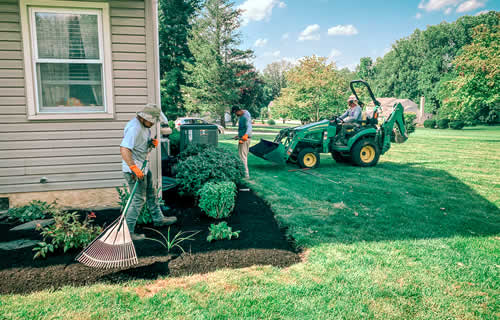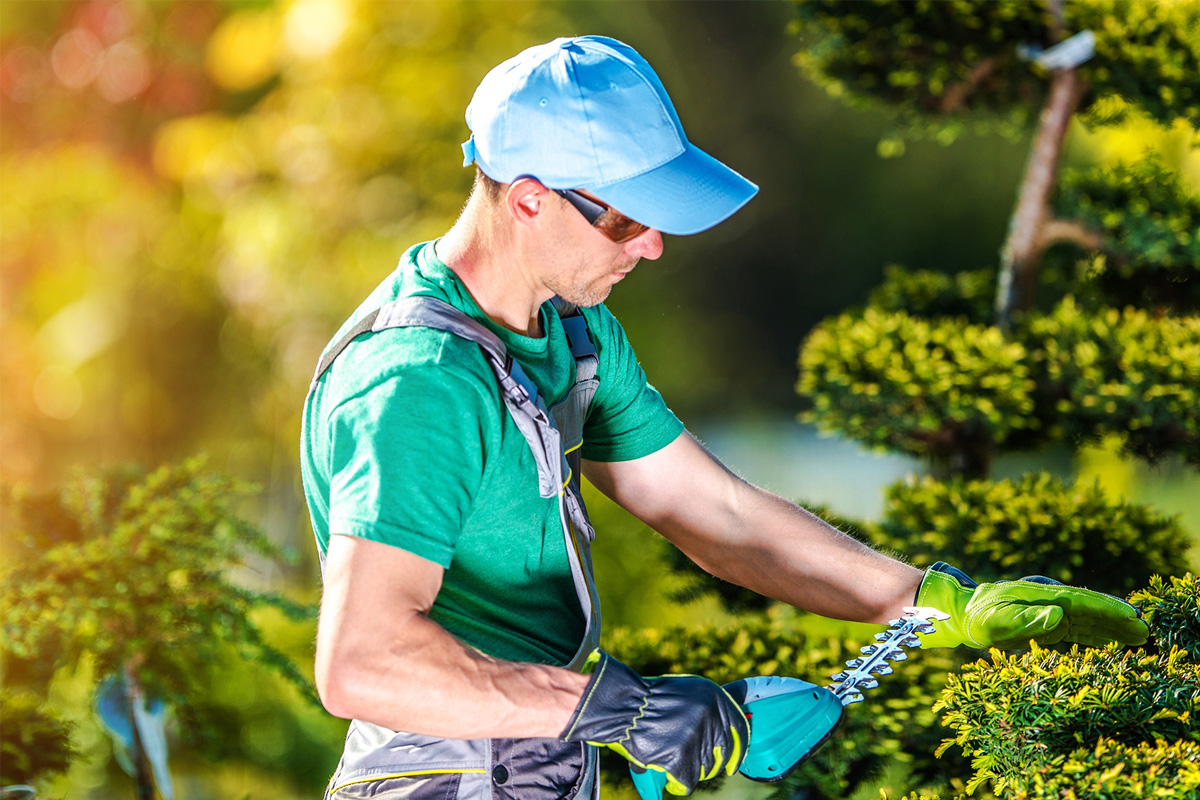Comprehending the Comprehensive Range of Functions in Professional Landscaping Services
The comprehensive range of professional landscape design services includes a variety of basic aspects. It includes landscape design concepts, plant selection, and hardscaping functions. Additionally, it resolves irrigation systems and upkeep techniques. Each element plays a crucial function in creating functional and cosmetically pleasing outside spaces. Recognizing how these elements function together can reveal much regarding the art and science of landscaping. Nonetheless, the trip into this detailed area is simply beginning.

Landscape Design Principles
Reliable landscape style principles are important for producing harmonious exterior rooms that enhance both visual allure and capability. These principles direct the plan of elements within the landscape, ensuring a natural aesthetic experience. Key elements consist of equilibrium, which disperses aesthetic weight equally; percentage, which relates the dimension of numerous aspects to every other and the room; and unity, which produces a feeling of integrity through constant styles and materials.
Focus guides interest to focal factors, while rhythm establishes activity with repeating of layout features. The reliable usage of line can produce pathways and guide the eye through the landscape. On top of that, recognizing the site's topography, climate, and existing attributes is necessary for combination with the surrounding atmosphere. By sticking to these foundational principles, landscape designers can craft spaces that not only look enticing yet also offer their intended function, improving the total experience for customers.
Plant Selection and Installation
In the domain name of expert landscaping, plant choice and installment play a critical function in achieving a flourishing yard - landscaping. Highlighting indigenous plant advantages, seasonal considerations, and the details dirt and sunshine needs of each varieties assures a sustainable and visually pleasing landscape. Mindful planning in these locations not just boosts biodiversity however additionally promotes long-term eco-friendly health
Indigenous Plant Benefits
Why should house owners consider native plants for their landscape design jobs? Indigenous plants use numerous benefits that enhance both looks and ecological sustainability. They are well-adapted to neighborhood climates, needing much less water and upkeep contrasted to non-native varieties. This durability reduces the demand for chemical plant foods and pesticides, advertising a healthier ecosystem. Additionally, native plants provide environment and food for regional wildlife, including pollinators, which can raise biodiversity in suburbs. Their familiarity with regional dirt and weather additionally causes much better development rates and durability. By picking indigenous plants, house owners not only create visually attractive landscapes however likewise add to eco-friendly preservation, making a positive effect on their regional atmosphere. Subsequently, native plants represent a wise selection for landscaping jobs.
Seasonal Plant Considerations
Property owners who have actually accepted indigenous plants in their landscaping can even more improve their exterior areas by thinking about seasonal plant selections. By incorporating plants that thrive in particular seasons, they can develop aesthetically enticing and dynamic landscapes throughout the year. Springtime may introduce vivid flowers like daffodils and tulips, while summer can display lush foliage and vibrant perennials. Fall presents a scheme of cozy tones with asters and goldenrods, while winter season can be highlighted with evergreens and ornamental turfs for appearance. Expert landscapers usually suggest selecting plants that not just enhance existing indigenous varieties but additionally offer year-round passion and assistance regional wild animals. This thoughtful method to seasonal plant option ensures a consistently evolving and lasting garden setting.
Dirt and Sunlight Needs
Effective landscape design hinges on understanding the certain soil and sunshine requirements of plants. Different varieties prosper under differing conditions, needing a careful evaluation of both elements throughout the option procedure (landscaping). Soil types, such as sandy, clay, or loamy, influence water drainage, nutrition accessibility, and origin development. Furthermore, pH degrees can affect plant wellness, necessitating soil screening to establish suitability. Sunshine demands differ significantly; some plants thrive in full sun, while others choose complete or partial shade. An expert landscaper takes into consideration these elements to guarantee peak development and aesthetic appeal. By aligning plant options with the setting's specific features, landscapes can attain sustainability, strength, and aesthetic consistency, ultimately resulting in successful plant establishment and long-lasting maintenance
Hardscaping Attributes and Construction
While landscape design often evokes photos of lush greenery and vivid flowers, hardscaping functions play a vital function in defining outside rooms. These components, which consist of patios, pathways, retaining wall surfaces, and ornamental stonework, give structure and functionality to lawns and gardens. Hardscaping utilizes products such as concrete, wood, stone, and block, enabling diverse styles that match the all-natural landscape.
The construction of hardscaping attributes requires careful planning and execution to guarantee durability and visual charm. Professionals assess site conditions, water drainage, and spatial partnerships to produce cohesive exterior atmospheres. Correct installation techniques are essential, as they avoid problems like disintegration and moving with time.
Integrating hardscaping not just boosts the visual rate of interest of a residential or commercial property but also helps with outside tasks, making it an essential element of complete landscape design services. Eventually, thoughtful hardscaping adds to both the performance and elegance of outside spaces.
Watering Solutions and Water Management
Effective watering systems and water monitoring are crucial elements of professional landscaping, as they assure that plants get the needed hydration for perfect development. These systems can differ from simple drip watering configurations to advanced automated automatic sprinkler, created to fulfill the particular requirements of diverse landscapes. Correct water management not only optimizes water usage, decreasing waste, yet additionally enhances plant health and wellness and reduces condition risks.
Landscape design specialists assess numerous factors, including dirt type, plant species, and neighborhood climate, to establish customized irrigation options. In addition, incorporating rain harvesting methods can further improve sustainability and performance (Read More). Routine upkeep of irrigation systems is important to preserve functionality and prevent leakages, which can bring about water loss and increased prices. Inevitably, a well-designed irrigation system plays a pivotal role in protecting the visual appeal of outdoor rooms while advertising environmental stewardship within professional landscape design practices
Yard Treatment and Maintenance Techniques
Lawn treatment and maintenance techniques are basic for achieving a lush, healthy lawn that enhances the total landscape. These techniques encompass numerous techniques intended at promoting ideal development and visual appeal. Regular mowing is necessary, as it urges thick, try this site even development while stopping weeds from establishing. Additionally, correct fertilizing supplies needed nutrients, with applications customized to the particular yard type and dirt problems.
Watering techniques need to concentrate on deep, infrequent irrigation to motivate origin advancement, while aeration improves soil structure and advertises nutrition absorption. Bug and disease management is additionally essential; recognizing issues early enables for effective treatments that lessen damage.
Overseeding can renew slim or broken grass, enhancing thickness and color. By carrying out these targeted yard care approaches, landscaping professionals can assure that backyards continue to be vivid and healthy and balanced throughout the periods, greatly adding to the total elegance of the building
Seasonal Landscape Treatment and Upkeep
As the seasons adjustment, proper landscape treatment becomes vital for preserving the health and charm of outside rooms. Each period offers distinct challenges and demands. In springtime, landscape professionals concentrate on trimming, growing, and feeding to motivate development. Summer season demands normal watering, weed control, and bug administration to secure freshly developed plants.
Autumn calls for the preparation of yards for winter, consisting of mulching, leaf elimination, and the growing of bulbs for the following springtime. Furthermore, winter season care involves shielding at risk plants from frost and guaranteeing that hardscapes are secure and practical.
Throughout the year, seasonal landscape maintenance assurances that exterior areas remain healthy and visually appealing. Professional services can supply tailored upkeep plans that adjust to the specific needs of each season, allowing residential property owners to enjoy dynamic landscapes year-round. Generally, seasonal treatment is an important aspect of expert landscape design that advertises durability and visual worth.
Sustainable Landscape Design Practices
A growing variety of property proprietors are welcoming sustainable landscaping methods to develop ecologically pleasant outdoor spaces. These techniques concentrate on saving sources, boosting biodiversity, and reducing environmental impact. Indigenous plants are frequently chosen for their low tide requirements and compatibility with regional environments, decreasing the demand for chemical fertilizers and chemicals. Rainfall gardens and permeable paving are utilized to manage stormwater overflow, advertising groundwater recharge and lowering erosion.
Lasting landscape design includes natural gardening methods that focus on dirt health and advertise natural pest control. Reliable watering systems, such as drip watering and rainwater harvesting, help optimize water usage. In addition, landscape developers increasingly support for the usage of recycled products, such as reclaimed wood and rocks, to lessen waste. By taking on these lasting practices, residential or commercial property owners not just contribute to environmental preservation however additionally produce aesthetically pleasing atmospheres that can flourish with marginal maintenance.
Frequently Asked Questions
The length of time Does a Landscaping Job Usually Take to Complete?
Commonly, a landscaping job can take anywhere from a few days to several weeks to complete, relying on the task's complexity, dimension, and style demands. Read More. Elements such as weather condition and source accessibility also affect timelines
What Elements Impact the Price of Landscape Design Services?
Various elements affect landscape design solution expenses, consisting of job size, style intricacy, material top quality, labor expenditures, geographic place, and seasonal need. Each component contributes distinctively to the overall financial demands of a landscaping job.
Are Landscape Design Services Available Year-Round?
Landscape design services are generally readily available year-round, although availability might differ based upon region, seasonal climate condition, and particular solution offerings. Some services could be limited throughout extreme weather condition or off-peak periods.
Do Landscaping Companies Offer Warranties on Their Work?

Can I Design My Landscape Without Professional Assist?
Yes, individuals can create their landscapes without specialist assistance. Nevertheless, they may do not have knowledge in plant selection, format, and ecological factors to consider, potentially bring about less reliable layouts that could require expensive changes later.
